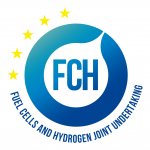This story about the FCHgo pilot classroom activities comes from Italy. Paola Morelli tells us her experience with the FCHgo educational path.
Hello, I am Paola Morelli and I have been the expert for the FCHgo project in different primary and secondary schools in 2019-2020 in the province of Modena, Italy.
This is the story of the educational path that I have ran together with the teachers Chiara Facchetti and Donatella di Giuseppe in a 8th grade of the lower secondary school “Fiori” in Casinalbo.
Everything has started with the reading of “An Apple Story”. All pupils knew that the most important topic of the lesson was energy. Therefore, we asked the following question:
“What tells the Apple Story about energy? And why a story?”
Here are some pupils’ answers:
…the apple story can be related with energy because it can be used as a test case for the different experiments
…the apple produces energy
…in the apple one can find ingredients that produce energy
…the apple gives us energy when we eat it
…the sugars in the apple enter our organism and give us energy
The educational path has therefore followed a particular route, along the Apple Story, as we tried to understand, together with the pupils, the meaning of their naïve knowledge, and, in particular, of the last sentence reported above. The reading of “An Apple Story” helped with understanding the fundamentals of energy. This basic understanding was enriched by experimental activities that the pupils conducted in a next step: practical observations of the dynamo torch and of the rechargeable flashlight.
The observations were precise, detailed and meticulous: this has allowed the pupils to physically represent the studied objects in simple role plays and to point out the path followed by energy in each part of the objects. Hence, the story of energy transmission was interpreted by pupils using non-verbal language.
This has allowed them to understand the concepts of “carried” and “transferred” energy in an easy and immediate way.
This is how these concepts have been described by one pupil after three weeks of FCHgo lessons:
“…If we consider the car, we need fuel. If we travel by train, we will need diesel, electricity or coal. Fuel, coal, and diesel have something in common: they contain energy. Many devices and machines, and living organisms too, need energy to work. One can receive energy through fuel or food.
Fuel, coal, oil, gas and firewood are energy carriers.
Electricity is an energy carrier, it carries energy to the lamps and to the other electrical devices. There is no energy without a carrier. The energy is always associated to a carrier…”
“…The physical objects, the rotor, the generator and the engine are called couplers, because they couple the nature forces like water and the rotational movement…”
In order to have a feedback on the learning of the concepts of carrier and coupler, pupils watched the movie “Perpetuum Mobile” and analyzed objects used in everyday life. The results are depicted in the images below:
- The crank flashlight drawn by one pupil
- Another drawing of the crank flashlight
- Drawing of a hairdryer
Once the energy story – the concepts of carriers, exchangers and the involved potential differences – were grasped by pupils, they moved on to work with the fuel cell car. This allowed them to consolidate their learning process and to focus their attention on the advantages of hydrogen and fuel cell technology.
- Pupils activating the fuel cell
The feedbacks obtained during the process, the assessment of individual and group works as well as pupils’ active and attentive involvement, their precise and investigatory questions, and the results obtained after a few weeks demonstrate that the whole educational path successfully stimulated pupils’ ability for scientific analysis and raised their awareness for new energy technologies with less environmental impact.
You would like to know more about the eductional path proposed by FCHgo for exploring energy and fuel cells in class? Have a look at the educational materials, worksheets and guides for teachers at the FCHgo Toolkit page.







